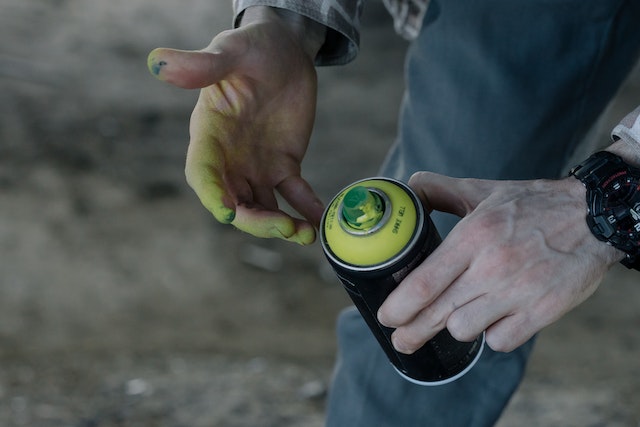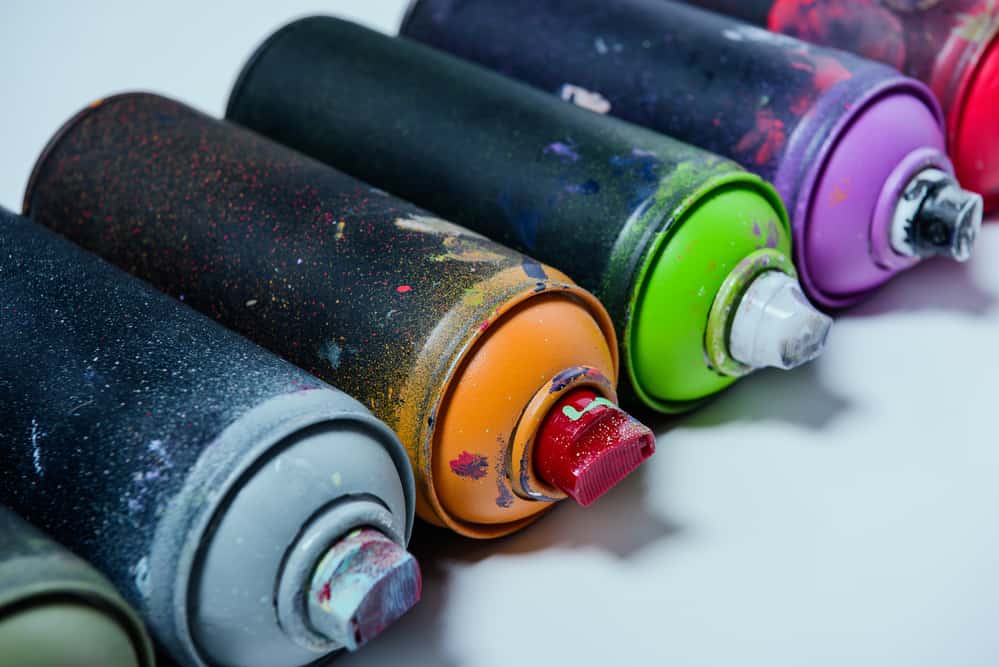Most high-quality spray paints create a tough coat with a glossy sheen that protects the substrate from the elements. Unfortunately, paint is still susceptible to physical damage and can easily sustain scratches and dents from impact.
You can protect the painted surface from weather elements and physical damage by sealing it. Sealing can go a long way in making the paint job more durable and long-lasting, with greater impact resistance than unsealed paint.
You could use a spray varnish or any other hardwearing sealant that is compatible with the paint used.
Read along to learn how to seal spray paint.
Do You Need to Seal Spray Paint?
No, sealing spray paint is optional. You can choose to skip sealing spray-painted surfaces if they are high-gloss or semi-gloss. However, you may consider sealing spray paints with lower sheens or if you wish to prolong the service life of the paint.
Sealing makes spray-painted surfaces significantly more durable and shinier, which may be more appealing for longer.
A coat of clear coat on the painted surface can protect it from scratching, peeling, chipping, and premature aging.
How to Seal Spray Paint on Any Surface
The first thing to do when sealing spray paint is to choose the right sealant. This could be polyurethane or varnish, the most durable clear coat ideal for use over any paint type.
Ideally, you want a clear sealer that will not affect the paint color. It should enhance it instead.
Tools and materials
- A suitable sealant
- A pair of hand gloves
- Respirator mask (optional)
- Drop cloth
- Applicator
- Fine grit sandpaper
- Tack cloth
How to Seal Spray Paint Step by Step
Once you have all the required supplies, follow the steps below to complete the paint project.
Step 1. Let the Spray Paint Surface Dry Completely
Various spray paints have different dry times. It is crucial to wait for the paint to dry completely before sealing it.
Applying a sealant over wet fresh paint or one that has not fully dried can lock in the moisture and prolong the dry time significantly.
For old paint that has been around for a while, ensure there is no moisture on the surface before sealing it. Moisture can result from water spillage or rainfall, depending on where the item is located.
Step 2. Prep the Workspace and Yourself
Spillages and sanding dust can mess up your floor, the ground underneath your workspace, and any objects around the area. Start by covering the ground and any objects with a drop cloth or plastic sheeting.
For a small project such as a wooden toy, you can use old newspapers to cover any surfaces nearby instead.
Also, wear a pair of hand gloves and protective clothing to protect your skin from contact with the sealer.
If you have an oil-based product, you may require a respirator mask, as such varnishes and polyurethanes tend to have strong odors and can emit toxic fumes or volatile organic compounds.
Step 3. Prep the Painted Surface
Check to ensure no dust or debris has settled on the painted surface. Otherwise, give it a wipe-down with a damp rag and let it dry before sealing it.
For an old paint surface, you may have to scrub the surface with soapy water and a scrubbing sponge to remove accumulated dirt and grime. Once you are done cleaning it, let it dry thoroughly before proceeding.
Step 4. Prepare the Sealant
How you prepare the sealant will depend on the product you have selected and the instructions on the label. In most cases, you will need to stir it with a stirring stick to mix the contents.
However, other sealants don’t require mixing, so you can use them as they are. Just open the can and follow the application instructions to use it.
Step 5. Test the Sealant in an Inconspicuous Area
Do not go straight to the project after opening the sealer and familiarizing yourself with the application instructions.
Instead, test patch the sealer in a small, inconspicuous area of your project. For instance, if you are sealing a painted plastic surface of a seat, test the product and the application mechanism on the underside of the furniture.
Testing allows you to check for any adverse reactions or changes in color or texture. Allow the test patch to completely dry before you assess and proceed.
Step 6. Apply the Sealant
Once you are happy with how the sealant looks on the test patch, apply the sealant on the rest of the project following the same technique.
The sealant should have a detailed procedure for using it. Ensure you pay attention to the manufacturer’s recommendations for the best results.
The information may include the recommended applicator, application method, drying time, and recoat times.
If you are using an aerosol can, you may need to shake the can properly to mix the paint particles and ready the contents before use. When applying such a sealant, ensure you maintain a consistent distance between the can and the surface to achieve an even application.
Apply an even, light coat of the sealant for the best results, and let it dry for the recommended time.
Step 7. Recoat
In most cases, you will need to apply multiple coats, often two to three coats of your chosen sealant, to achieve the desired coverage and maximum durability.
Once the first coat has dried, use a fine-grit sanding block to lightly sand and scuff up the surface a bit and wipe the sanding dust with a tack cloth before applying more light coats of the sealant.
Water-based sealers like water-based polyurethane over latex paint may not require sanding between coats. However, we recommend sanding between coats nonetheless to promote the best adhesion and durability.
Repeat the same procedure between each coat until you have applied the final one. More importantly, ensure you let each coat of sealant dry completely before adding the next.
Step 8. Let it Dry
Once you have applied the final coat of the sealant, let it dry thoroughly without any disturbance. This means keeping the painted item safely out of reach of children and pets until it has fully cured.

Does Spray Paint Stay on Metal?
Yes, metal is one of the surfaces that you can coat with spray paint. The paint adheres to metal surfaces well and can be pretty durable with proper surface preparation and the right application technique.
For spray paint to stick to metal and spay without chipping or peeling, ensure you clean the metal surface to remove dirt and grime.
For finished metal surfaces, you must sand down the existing coat of finish to remain with bare metal.
After sanding, apply a primer before painting the metal to help the underlying paint stick better. You can then seal the spray-painted metal with a clear topcoat for added durability. The same rule applies when painting plastic or wood.
How to Fix Spray Paint Drips – Spray Painting Tip
Sometimes you will end up with spray paint runs and drips on your project regardless of your skill level. Thankfully, these are relatively easy to fix. Here are a couple of tricks you can use to fix spray paint drips and runs:
- Wipe fresh drips with a lint-free cloth if you notice them on time
- Dilute the excess dripping paint with transparent color (or water for water-based paint) and then spray a transparent color on top. This creative method can create beautiful galactic effects on your project.
- Wait until the drips dry completely, and go over them with a fine sandpaper or scouring pad. This is the option when you do not catch the drips in time. It typically means waiting at least 24 hours before fixing the imperfection. You must then add another thin coat of paint after sanding.
These tips should apply across the board whether you spray paint plastic, wood, or metal. Read more on how to fix spray paint drips from Propaintersguide on fixing spray paint drips.
FAQs-How to Seal Spray Paint
What is the Best Way to Seal Spray Paint?
The best way to seal spray paint is using a compatible clear topcoat. Spray varnishes or polyurethanes are excellent options as they create even, thin coats over the spray-painted surface. They are easy to apply and allow for easier management of the thickness of the spray paint coat.
Both varnish and polyurethane are highly durable and create a hardwearing coat protecting the paint against the elements and physical damage.
What Should You Seal Spray Paint Sith?
The best product for sealing your spray paint from moisture, the sun’s ultraviolet rays, and other weather elements is varnish. The clear coat creates a glossy finish over the paint, making the paint color more vibrant while protecting it from discoloration, damage, and premature aging.
Do I Need Sealant for Spray Paint?
A sealant for spray paint is optional. However, sealing your spray-painted surface can improve the results by creating a high-gloss surface that makes the paint color pop. The sealant also creates a hardwearing coat over the paint that can significantly increase its durability and protect it from discoloration, scratches, dents, and the effect of weather elements.
Will a Clear Coat Make the Paint Shiny?
Yes, clear coats create an extra high-gloss layer over the paint that makes the paint color appear more vibrant through the extra shine. This can make the painted item look newer for longer. This extra shine can be particularly beneficial for paint with lower sheens, such as matte or satin options.
What Kind of Sealer Do You Use on Acrylic Paint?
The best kind of sealer for acrylic paint surfaces is an acrylic resin varnish, clear acrylic sealer, acrylic polymer varnish, or mod podge, depending on the substrate or material you are painting on. Each of these sealers provides varying levels of protection for the acrylic paint each can significantly enhance the vibrancy of the paint job.
Does Rust-Oleum Spray Paint Need a Top Coat?
Rust-Oleum spray paint typically doesn’t require a top coat. But it won’t hurt to apply a top coat anyway for an extra layer of protection and added durability for your painted furniture. You can use Rust-Oleum Clear Gloss Spray Paint for excellent results. This paint can go over flat spray paint to create a vibrant, glossy sheen.
Summary – Sealing Spray Paint
Sealing spray paint can be straightforward if you have the right sealer, know how to do it, and have the tools and materials to complete the job.
While applying a sealer over spray paint is typically not a requirement, doing so can significantly improve your results.
A coat of clear-colored sealer on a painted surface can make the paint color appear more vibrant with a glossier sheen. It can also help protect the painted surface from the elements and physical damage, prolonging its service life.
This article discusses how to seal spray paint in eight simple steps. We hope this makes your next project successful.
Let us know your thoughts in the comments.

